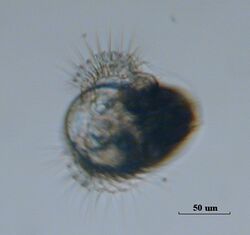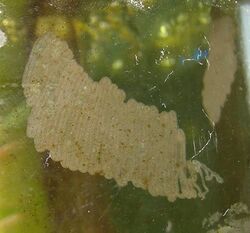Biology:Dolabrifera dolabrifera
| Dolabrifera dolabrifera | |
|---|---|

| |
| A live individual of Dolabrifera dolabrifera, head end at the upper left | |
| Scientific classification | |
| Domain: | Eukaryota |
| Kingdom: | Animalia |
| Phylum: | Mollusca |
| Class: | Gastropoda |
| Subclass: | Heterobranchia |
| Clade: | Euopisthobranchia |
| Clade: | Anaspidea |
| Superfamily: | Aplysioidea |
| Family: | Aplysiidae |
| Genus: | Dolabrifera |
| Species: | D. dolabrifera
|
| Binomial name | |
| Dolabrifera dolabrifera (Rang, 1828)
| |
| Synonyms[2] | |
| |
Dolabrifera dolabrifera is a species of sea hare, a marine gastropod mollusc in the family Aplysiidae, the sea hares.[3] Dolabrifera dolabrifera, otherwise known as a Warty Seacat.[4] The animal goes by many names, including the common sea hare.[5] The Hawaiian name for Dolabrifera dolabrifera, is Kualakai.[5]
Description & Biology
The Seacat is a flat sea hare that grows to about 10 cm long.[6] The maximum recorded length is 108 mm.[7] It is commonly spotty green or brown, but it can also be reddish.[6] The animal's back half is typically wider and rounded, it narrows towards the head.[6] Warty Seacats are soft-bodied gastropods, who have lost a protective shell over time.[4] All species of sea hares have ink glands for chemical defense, though Dolabrifera dolabrifera does not release ink.[8]
Distribution
This species is found in warm tropical and subtropical waters.[6]
Habitat
These animals are majorly preyed on in their habitat.[4] The Seacats live in shallow-flat pools that contain large boulders, near-shore.[4] Collections of the hares gather underneath rocks in the intertidal zone.[9] At night the warty Seacats hide themselves in between cracks found in the boulders.[4] During the day, when the tide rises, the Seacats emerge.[4] Due to the varying in color and pattern, it is hard to distinguish them from other species in the habitat.[10] The minimum recorded depth for this species is 0 m; the maximum recorded depth is 3 m.[11]
Life cycle

References
- ↑ Cuvier G. L. (1817). La Règne Animal. Volume 2. (Gasteropodes), Volume 4.
- ↑ Rudman W. B. (2003) "Dolabrifera dolabrifera (Rang, 1828) " . SeaSlugForum, accessed 16 September 2011.
- ↑ Bouchet, P. (2010). Dolabrifera dolabrifera (Rang, 1828). Accessed through: World Register of Marine Species at http://www.marinespecies.org/aphia.php?p=taxdetails&id=224652 on 31 March 2012
- ↑ 4.0 4.1 4.2 4.3 4.4 4.5 Himstead, Alexander; Wright, William G. (2018-03-04). "Precise foraging schedule in an intertidal euopisthobranch mollusk" (in en). Marine and Freshwater Behaviour and Physiology 51 (2): 131–141. doi:10.1080/10236244.2018.1505430. ISSN 1023-6244. https://www.tandfonline.com/doi/full/10.1080/10236244.2018.1505430.
- ↑ 5.0 5.1 "Aplysiidae - Marine Invertebrates of Kalaupapa National Historical Park". http://www.botany.hawaii.edu/basch/uhnpscesu/htms/kalainvr/family/aplysiid.htm.
- ↑ 6.0 6.1 6.2 6.3 jurisdiction=New South Wales; corporateName=Australian Museum; author=Rudman, W. B. (2010-07-15). "The Sea Slug Forum - Dolabrifera dolabrifera" (in en). http://www.seaslugforum.net/showall/doladola.
- ↑ Welch, John J. (2010-01-19). Joly, Simon. ed. "The "Island Rule" and Deep-Sea Gastropods: Re-Examining the Evidence" (in en). PLOS ONE 5 (1): e8776. doi:10.1371/journal.pone.0008776. ISSN 1932-6203. PMID 20098740.
- ↑ Prince, Jeffrey S.; Johnson, Paul Micah (2006-11-01). "Ultrastructural comparison of Aplysia and Dolabrifera ink glands suggests cellular sites of anti-predator protein production and algal pigment processing" (in en). Journal of Molluscan Studies 72 (4): 349–357. doi:10.1093/mollus/eyl017. ISSN 1464-3766. http://academic.oup.com/mollus/article/72/4/349/2883174/Ultrastructural-comparison-of-Aplysia-and.
- ↑ Hoover, John P. (2010). Hawai'i's sea creatures : a guide to Hawai'i's marine invertebrates. Mutual Pub. ISBN 978-1-56647-220-3. OCLC 1293454919. http://worldcat.org/oclc/1293454919.
- ↑ Valdés, Ángel; Breslau, Eric; Padula, Vinicius; Schrödl, Michael; Camacho, Yolanda; Malaquias, Manuel António E; Alexander, Jennifer; Bottomley, Morgan et al. (2018-09-01). "Molecular and morphological systematics of Dolabrifera Gray, 1847 (Mollusca: Gastropoda: Heterobranchia: Aplysiomorpha)" (in en). Zoological Journal of the Linnean Society 184 (1): 31–65. doi:10.1093/zoolinnean/zlx099. ISSN 0024-4082. PMID 30319150. PMC 6169219. https://academic.oup.com/zoolinnean/article/184/1/31/4781679.
- ↑ Welch J. J. (2010). "The "Island Rule" and Deep-Sea Gastropods: Re-Examining the Evidence". PLoS ONE 5(1): e8776. doi:10.1371/journal.pone.0008776.
- Keen M. (1971). Sea shells of Tropical West America. Marine mollusks from Baja California to Perú. (2nd edit.). Stanford University Press pp. 1064:
- Bebbington A. (1977) Aplysiid species from Eastern Australia with notes on the Pacific Ocean Aplysiomorpha (Gastropoda, Opisthobranchia). Transactions of the Zoological Society of London 34: 87-147.
- Rolán E., 2005. Malacological Fauna From The Cape Verde Archipelago. Part 1, Polyplacophora and Gastropoda.
- Rosenberg, G., F. Moretzsohn, and E. F. García. 2009. Gastropoda (Mollusca) of the Gulf of Mexico, Pp. 579–699 in Felder, D.L. and D.K. Camp (eds.), Gulf of Mexico–Origins, Waters, and Biota. Biodiversity. Texas A&M Press, College Station, Texas.
Further reading
- Powell A. W. B., New Zealand Mollusca, William Collins Publishers Ltd, Auckland, New Zealand 1979 ISBN:0-00-216906-1
Wikidata ☰ Q3167834 entry
 |



